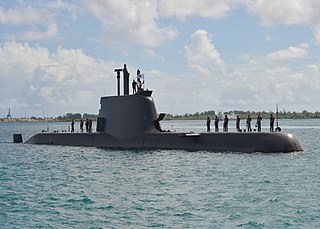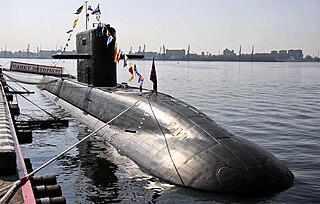Related Research Articles

The Type 212A is a class of diesel-electric submarine developed by Howaldtswerke-Deutsche Werft AG (HDW) for the German Navy, and the Italian Navy where it is known as the Todaro class. It features diesel propulsion and an additional air-independent propulsion (AIP) system using Siemens proton-exchange membrane (PEM) compressed hydrogen fuel cells. The submarines can operate at high speed on diesel power or switch to the AIP system for silent slow cruising, staying submerged for up to three weeks with little exhaust heat. The system is also said to be vibration-free and virtually undetectable.

An attack submarine or hunter-killer submarine is a submarine specifically designed for the purpose of attacking and sinking other submarines, surface combatants and merchant vessels. In the Soviet and Russian navies they were and are called "multi-purpose submarines". They are also used to protect friendly surface combatants and missile submarines. Some attack subs are also armed with cruise missiles, increasing the scope of their potential missions to include land targets.

The Dolphin class is a diesel-electric submarine developed in Israel and constructed by Howaldtswerke-Deutsche Werft AG (HDW) in Kiel, Germany, for the Israeli Navy. The first boats of the class were based on the export-only German 209-class submarines, but modified and enlarged. The Dolphin 1 sub-class is slightly larger than the German Navy Type 212 in length and displacement. The three newer air-independent propulsion (AIP) equipped boats are similar to the Type 212 vessels in underwater endurance, but are 12 metres (39 ft) longer, nearly 500 tonnes heavier in submerged displacement and have a larger crew than either the Type 212 or the Type 214.
Air-independent propulsion (AIP), or air-independent power, is any marine propulsion technology that allows a non-nuclear submarine to operate without access to atmospheric oxygen. AIP can augment or replace the diesel-electric propulsion system of non-nuclear vessels.

The Type 214 is a class of diesel-electric submarines developed exclusively for export by Howaldtswerke-Deutsche Werft GmbH (HDW). It features diesel propulsion with an air-independent propulsion (AIP) system using Siemens polymer electrolyte membrane (PEM) hydrogen fuel cells. The class combines the design principles of the Type 209 submarine family and the features of the Type 212A submarine. However, as an export design, it lacks some of the classified technologies of the Type 212 such as the non-magnetic steel hull that makes it difficult to detect using a magnetic anomaly detector.

The Scorpène-class submarines are a class of diesel-electric attack submarines jointly developed by the French Naval Group and the Spanish company Navantia. It features diesel propulsion and an additional air-independent propulsion (AIP). It is now marketed as the Scorpène 2000.

Lada class, Russian designation Project 677 Lada is the new advanced class of diesel-electric attack submarine designed by the Russian Rubin Design Bureau. A program to develop a "fourth generation" diesel-electric submarine, it aimed to produce a highly improved version of the Project 636 with better acoustic signature, new combat systems and possibly air-independent propulsion. However, in 2019, Alexander Buzakov, the head of the Admiralty Shipyard, indicated that there were no plans to equip the Lada class with an air-independent propulsion system. In July 2022 it was reported that work on an electrochemical generator to produce hydrogen from diesel fuel and oxygen was continuing and that the Rubin Central Design Bureau signed a new contract in 2019 to continue work. This was scheduled to be completed by the mid-2020s. In 2023, the decision was taken to decommission and scrap the lead ship of the class, the Sankt Peterburg due to the very high costs of modernising the submarine.

The Sōryū-class submarines (16SS) are diesel-electric attack submarines. The first boat in the class entered service with the Japan Maritime Self-Defense Force in 2009. The design is an evolution of the Oyashio-class submarine, from which it can most easily be distinguished by its X-shaped stern combination diving planes and rudders. The Sōryūs have the largest displacement of any submarine used by post-war Japan.

The Type 209 is a range of diesel-electric attack submarines developed exclusively for export by Howaldtswerke-Deutsche Werft of Germany. Five class variants, including modifications thereof, have been successfully exported to 15 countries, with 68 submarines being built and commissioned to five different variants between 1971 and 2021. More boats have been built to modified designs.
The Blekinge-class submarine is the next generation of submarines developed by Kockums for the Swedish Navy, also known as the A26 type.
The S-80 Plus class is a Spanish class of four submarines being built by the state-owned Spanish company Navantia at its Cartagena shipyard for the Spanish Navy. In common with other contemporary submarines, they feature air-independent propulsion.
SSK was the United States Navy hull classification symbol for a diesel-electric submarine specialized for anti-submarine duties. SS indicated that the vessel was a submarine, and the K suffix that it was a hunter-killer. The United States Navy does not currently operate any submarines of this type, and so the designation is inactive.
The Invincible-class submarines, formally classified as the Type 218SG submarines, is a class of conventionally-powered attack submarines, ordered by the Republic of Singapore Navy (RSN) from German-based naval conglomerate ThyssenKrupp Marine Systems (TKMS). The Type 218SG is an extensively-customised derivative of the export-oriented Type 214 submarine, with specific design characteristics drawn from Type 212 submarines. They feature several capabilities, including a substantial level of automation, a significant payload capacity, enhanced underwater endurance and superlative ergonomics.

Project-75 (India), simply referred to as the P-75(I) program, is a military acquisition initiative affiliated to India's Ministry of Defence (MoD), aimed at the planned procurement of diesel-electric submarines for the Indian Navy (IN). Originally conceived in 1997, the initiative's objective has been to procure a class of six conventionally-powered attack submarines for the Indian Navy Submarine Arm, as a replacement for the force's Sindhughosh-class submarines.

The KSS-III or Dosan Ahn Changho-class is a series of diesel-electric attack submarines currently being built for the Republic of Korea Navy (ROKN), jointly by Hanwha Ocean and HD Hyundai Heavy Industries (HHI). The KSS-III is the final phase of the Korean Attack Submarine program, a three-phased program to build 27 attack submarines for the ROKN, between 1994–2029.

The Taigei-class submarines (29SS) (Japanese: たいげい, "Big Whale") is a new class of attack submarines after 2022, developed for the Japan Maritime Self-Defense Force. It is the successor to the Sōryū class.

The Hai Kun-class submarine, alternatively known as the Indigenous Defense Submarine (IDS) program, is a class of attack submarines built by CSBC Corporation, Taiwan for the Republic of China Navy. While the Hai Kun class is thought to be based on the Dutch Zwaardvis class, which is currently operated by Taiwan, the design has been brought up to date by incorporating many new and more modern systems.
The Type 212CD class is a submarine class developed by ThyssenKrupp Marine Systems (TKMS) for the Norwegian and German navies. The class is derived from the Type 212 submarine class, but will be significantly larger than the 212 class.
The Dakar-class submarine is a class of AIP-capable, diesel-electric attack submarines ordered by the Israeli Navy from German-based naval conglomerate ThyssenKrupp Marine Systems (TKMS).
The Hangor-class submarines are a class of diesel–electric attack submarines currently being manufactured by a joint-partnership of the China Shipbuilding Industry Corporation (CSIC) and the Karachi Shipyard & Engineering Works (KSEW) for the Pakistan Navy (PN). Eponymously christened after the former-Daphné-class submarines that the Pakistan Navy operated between 1970 and 2006, the class is an export derivative of the Chinese-origin Type 039B (Upgraded)/041 attack submarine, currently operated by the People's Liberation Army Navy (PLAN). First unveiled to the public in 2018, the future submarines are envisaged to undertake anti-access/area denial operations within Pakistan's exclusive economic zone, through the use of heavyweight torpedoes and anti-ship cruising missiles.
References
- 1 2 HDW Class 216 Archived 2013-12-06 at the Wayback Machine
- ↑ "Type 216 U-216 Conventional AIP Submarine (SSK)". Navy Recognition. Retrieved 2020-07-27.
- ↑ "U-boats may be on navy's shopping list". The Canberra Times. 28 December 2011. Archived from the original on 24 June 2018. Retrieved 24 June 2018.
- ↑ Henderson, Anna (26 April 2016). "Australian submarines to be built in Adelaide after French company DCNS wins $50b contract". ABC News . Retrieved 14 May 2016.
- ↑ Andrew, Greene; Andrew, Probyn; Stephen, Dziedzic (15 September 2021). "Australia to get nuclear-powered submarines, scrap $90b plan to build French-designed subs". ABC News. Archived from the original on 15 September 2021. Retrieved 27 December 2023.
- ↑ Sharma, Soumya (14 December 2022). "TKMS launches Singapore's second and third Type 218SG submarines". Naval Technology. Retrieved 23 December 2022.